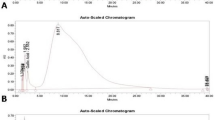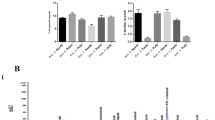Abstract
In order to promote breeding programs and a full reintroduction into production of two local red-fleshed apple varieties grown in Bekran and Bastam (Iran), the evaluation of their antioxidant properties was of interest. LC-MSn based metabolic fingerprinting analyses were applied to investigate the anthocyanin content of both peel and flesh components of the fruits. Cyanidin-3-O-hexoside isomers were present in both ‘Bekran’ and ‘Bastam’ apples, whereas ‘Bekran’ apple was a valuable source of anthocyanin rutinose derivatives. Employing DPPH•, ABTS•+, and ORAC methods, the antiradical efficacy was evaluated. The ability of the investigated fruit components to scavenge OH•, and O2 •- reactive species was also assessed. ID50 values highlighted the massive antioxidant response of ‘Bekran’ peel component, able to counteract by 50 % OH•, and O2 •- at 130.3 and 91.6 μg/mL, respectively. The cytoprotective screening towards HeLa, HepG2, A549, SH-5YSY, and SK-N-BE(2)-C cell lines evidenced that the investigated Iranian red-fleshed apple fruits were able to exert a significant antioxidant response in hydrogen peroxide oxidized cell systems. Data collected suggested that the revaluation of ‘Bekran’ and ‘Bastam’ apple cultivars could represent a precious source of antioxidant compounds whose dietary intake could improve the human well-being reducing risks of free radical related chronic and degenerative diseases.


Similar content being viewed by others
Abbreviations
- ABTS:
-
2,2′-azinobis (3-ethylbenzothiazoline-6-sulfonic acid) diammonium salt
- AAPH:
-
2,2′-Azobis(2-amidinopropane) dihydrochloride
- DPPH:
-
2,2-Diphenyl-1-picrylhydrazyl
- LC-MS:
-
Liquid romatography mass spectrometry
- MTT:
-
3-(4,5-Dimethylthiazol-2-yl)-2,5-Diphenyltetrazolium Bromide
- ORAC:
-
Oxygen radical absorbance capacity
- TEAC:
-
Trolox equivalent antioxidant capacity
References
Hyson DAA (2011) Comprehensive review of apples and apple components and their relationship to human health. Adv Nutr 2:408–420
Yao LH, Jiang YM, Shi J, Tomás-Barberán FA, Datta N, Singanusong R, Chen SS (2004) Flavonoids in food and their health benefits. Plant Foods Hum Nutr 59:113–122
Crichton GE, Bryan J, Murphy KJ (2013) Dietary antioxidants, cognitive function and dementia—a systematic review. Plant Foods Hum Nutr 68:279–292
Boyer J, Liu RH (2004) Apple phytochemicals and their health benefits. Nutr J 3:5. doi:10.1186/1475-2891-3-5
Cai Z, Zhao B, Ratka A (2011) Oxidative stress and β-amyloid protein in Alzheimer’s disease. Neuromol Med 13:223–250. doi:10.1007/s12017-011-8155-9
Rahman K (2007) Studies on free radicals, antioxidants, and co-factors. Clin Interv Aging 2:219–236
Wojdyáo A, OszmiaĔski J, Laskowski P (2008) Polyphenolic compounds and antioxidant activity of new and old apple varieties. J Agric Food Chem 56:6520–6530
Tsao R, Yang R, Young JC, Zhu H (2003) Polyphenolic profiles in eight apple cultivars using high-performance liquid chromatography (HPLC). J Agric Food Chem 51:6347–6353
Faramarzi Sh, Yadollahi A, Soltani BM (2014) Preliminary evaluation of genetic diversity among Iranian red fleshed apples using microsatellite markers. J Agric Sci Technol 16:373–384. http://jast.modares.ac.ir/article_10501_5044.html
Mazza G, Velioglu YS (1992) Anthocyanins and other phenolic compounds in fruit of red-flesh apples. Food Chem 43:113–117
Sadilova E, Stintzing FC, Carle R (2006) Chemical quality parameters and anthocyanin pattern of red-fleshed Weirouge apples. J Appl Bot Food Qual 80:82–87. http://pub.jki.bund.de/index.php/JABFQ/article/view/2193/2579
Ghosh D, Konishi T (2007) Anthocyanins and anthocyanin-rich extracts: role in diabetes and eye function. Asia Pac J Clin Nutr 16:200–208
Bagchi D, Sen CK, Bagchi M, Atalay M (2004) Anti-angiogenic, antioxidant, and anti-carcinogenic properties of a novel anthocyanin-rich berry extract formula. Biochemistry (Mosc) 69:75–80
Damyar S, Hassani D, Dastjerdi R, Hajnajari H, Zeinanloo AA, Fallahi E (2007) Evaluation of Iranian native apple cultivars and genotypes. Int J Food Agric Environ 5:211–215. https://www.researchgate.net/publication/240631419_Evaluation_of_Iranian_native_apple_cultivars_and_genotypes.
Pacifico S, Gallicchio M, Lorenz P, Potenza N, Galasso S, Marciano S, Fiorentino A, Stintzing FC, Monaco P (2013) Apolar Laurus nobilis leaf extracts induce cytotoxicity and apoptosis towards three nervous system cell lines. Food Chem Toxicol 62:628–637
Di Maro A, Pacifico S, Fiorentino A, Galasso S, Gallicchio M, Guida V, Severino V, Monaco P, Parente A (2013) Raviscanina wild asparagus (Asparagus acutifolius L.): a nutritionally valuable crop with antioxidant and antiproliferative properties. Food Res Int 53:180–188
Pacifico S, Gallicchio M, Fiorentino A, Fischer A, Meyer U, Stintzing FC (2012) Antioxidant properties and cytotoxic effects on human cancer cell lines of aqueous fermented and lipophilic quince (Cydonia oblonga Mill.) preparations. Food Chem Toxicol 50:4130–4135
Pacifico S, Gallicchio M, Lorenz P, Duckstein SM, Potenza N, Galasso S, Marciano S, Fiorentino A, Stintzing FC, Monaco P (2014) Neuroprotective potential of Laurus nobilis antioxidant polyphenol-enriched leaf extracts. Chem Res Toxicol 27:611–626
Telias A, Lin-Wang K, Stevenson DE, Cooney JM, Hellens RP, Allan AC (2011) Apple skin patterning is associated with differential expression of MYB10. BMC Plant Biol 11:93
Malubagal V, Van Nocker S, Dewitt DL, Nair MG (2007) Cultivars of apple fruits that are not marketed with potential for anthocyanin production. J Agric Food Chem 55:8165–8169
Guimarães R, Barros L, Dueñas M, Carvalho AM, Queiroz MJ, Santos-Buelga C (2013) Characterization of phenolic compounds in wild fruits from Northeastern Portugal. Food Chem 141:3721–3730
Cantos E, Espín JC, Tomás-Barberán FA (2002) Varietal differences among the polyphenol profiles of seven table grape cultivars studied by LC-DAD-MS-MS. J Agric Food Chem 50:5691–5696
Stefova M, Ivanova V (2011) Analytical methodology for characterization of grape and wine phenolic bioactives. In: Fruit and cereal bioactives: sources, chemistry, and applications. CRC Press, Taylor & Francis Group, p 409–427
Sentandreu E, Navarro JL, Sendra JM (2010) LC-DAD-ESI/MS(n) determination of direct condensation flavanol-anthocyanin adducts in pressure extracted pomegranate (Punica granatum L.) juice. J Agric Food Chem 58:10560–10567
He J, Santos-Buelga C, Mateus N, de Freitas V (2006) Isolation and quantification of oligomeric pyranoanthocyanin-flavanol pigments from red wines by combination of column chromatographic techniques. J Chromatogr A 1134:215–225
Ivanova V, Stefova M (2011) Phenolic bioactives in grapes and grape-based products. In: Fruit and cereal bioactives: sources, chemistry, and application. CRC Press, Taylor & Francis Group, p 171–184
Sentandreu E, Navarro JL, Sendra JM (2012) Identification of new coloured anthocyanin-flavanol adduct in pressure-extracted pomegranate (Punica granatum L.) juice by high-performance liquid chromatography/electrospray ionization mass spectrometry. Food Anal Methods 5:702–709
Cejudo-Bastantea MJ, Hermosín-Gutiérrez I, Pérez-Coello MS (2011) Micro-oxygenation and oak chip treatments of red wines: effects on colour-related phenolics, volatile composition and sensory characteristics. Part II: Merlot wines. Food Chem 124:738–748
Faramarzi S, Yadollahi A, Sadraei K, Pacifico S, Jemrić T (2014) Comparison of phenolic compounds and antioxidant activity between some native Iranian apples and standard cultivar ‘Gala’. J Agric Sci Technol 16:1601–1611. http://jast.modares.ac.ir/article_11767_5044.html
Collier AC, Pritsos CA (2003) The mitochondrial uncoupler dicumarol disrupts the MTT assay. Biochem Pharmacol 66:281–287
Stone JR, Yang S (2006) Hydrogen peroxide: a signaling messenger. Antioxid Redox Signal 8:244–268
Graziani G, D’Argenio G, Tuccillo C, Loguercio C, Ritieni A, Morisco F (2005) Apple polyphenol extracts prevent damage to human gastric epithelial cells in vitro and to rat gastric mucosa in vivo. Gut 54:193–200
D’Angelo S, Cimmino A, Raimo M, Salvatore A, Zappia V, Galletti P (2007) Effect of reddening-ripening on the antioxidant activity of polyphenol extracts from cv. ‘Annurca’ apple fruits. J Agric Food Chem 55:9977–9985
Acknowledgments
ESI-MS spectra were obtained using a LC-TQ MS instrument of the CRdC ‘Analisi e Monitoraggio del Rischio Ambientale’ AMRA (P.O.R. 2000-2006, Misura 3.16).
Conflict of Interest
The authors declare that they have no conflict of interests
Author information
Authors and Affiliations
Corresponding author
Electronic supplementary material
Below is the link to the electronic supplementary material.
Supplemented Material
(DOCX 15 kb)
Rights and permissions
About this article
Cite this article
Faramarzi, S., Pacifico, S., Yadollahi, A. et al. Red-fleshed Apples: Old Autochthonous Fruits as a Novel Source of Anthocyanin Antioxidants. Plant Foods Hum Nutr 70, 324–330 (2015). https://doi.org/10.1007/s11130-015-0497-2
Published:
Issue Date:
DOI: https://doi.org/10.1007/s11130-015-0497-2




